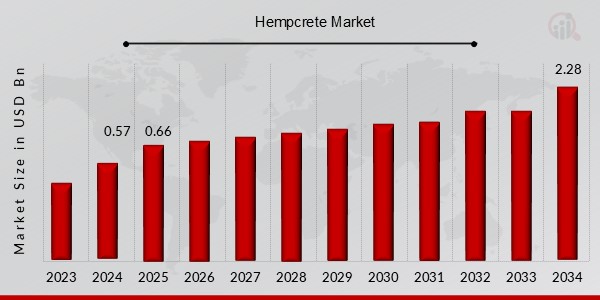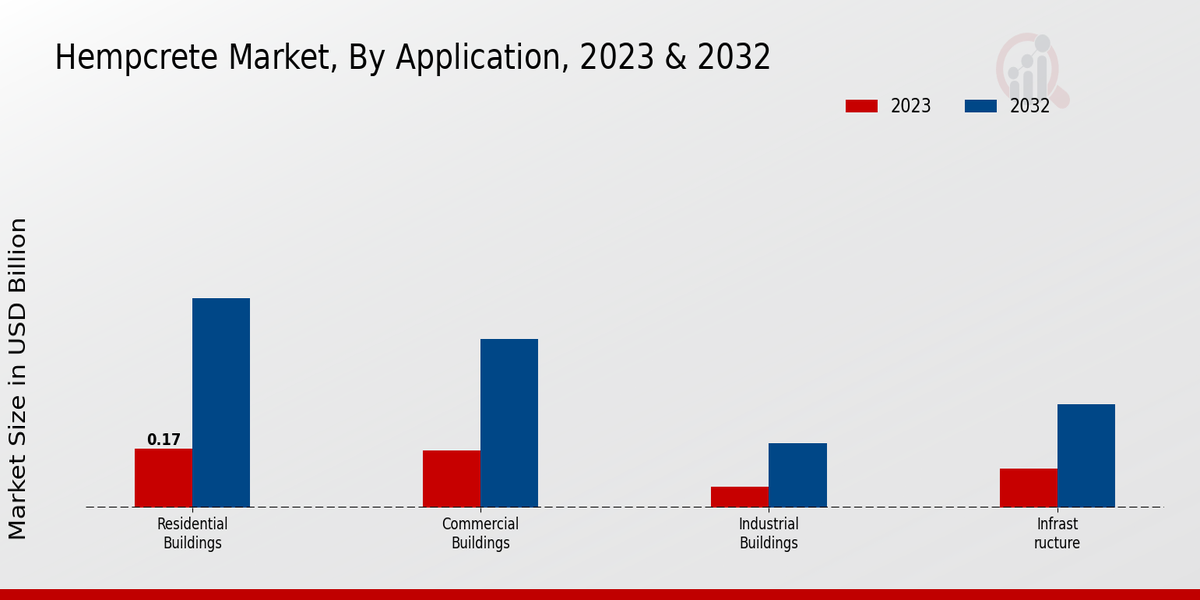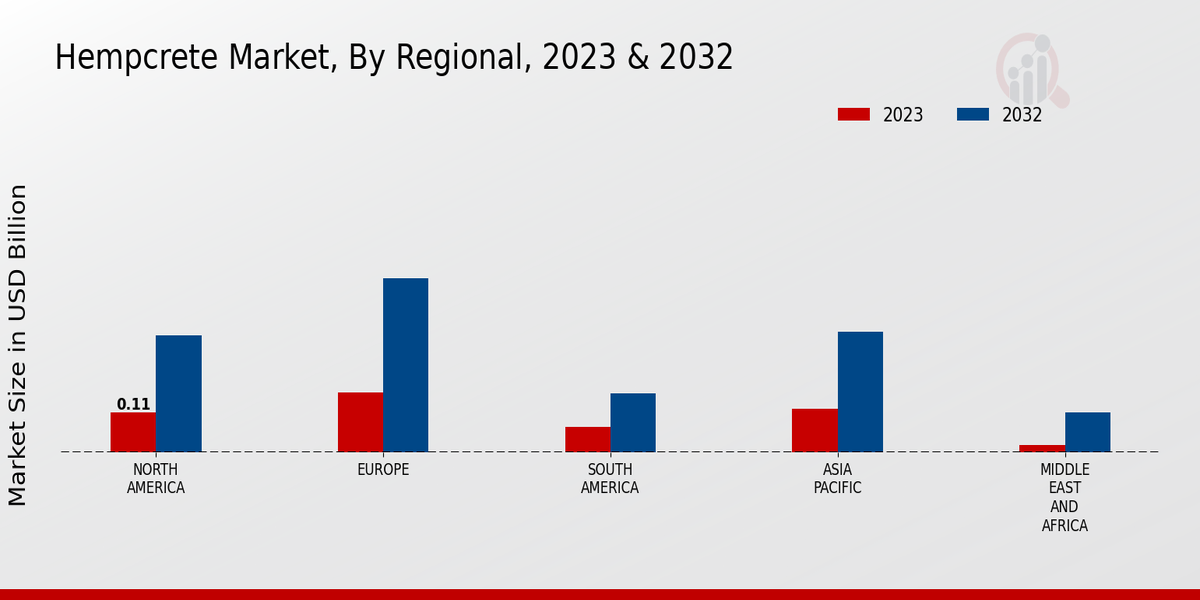Global Hempcrete Market Overview
The Hempcrete Market Size was estimated at 0.57 (USD Billion) in 2024.The Hempcrete Industry is expected to grow from 0.66(USD Billion) in 2025 to 2.28 (USD Billion) by 2034. The Hempcrete Market CAGR (growth rate) is expected to be around 14.8% during the forecast period (2025 - 2034).
Key Hempcrete Market Trends Highlighted
Hempcrete, an innovative material crafted from hemp shiv and lime, is gaining prominence in the construction industry. Its remarkable resilience, fire resistance, and insulating properties make it an attractive alternative to traditional materials. Growing environmental awareness and the push for sustainable building practices are among the key drivers propelling the expansion of the hempcrete market.Opportunities abound in the research and development of enhanced hempcrete formulations, exploring its potential in seismic-prone areas and studying its long-term performance. Moreover, the advent of prefabricated hempcrete construction methods presents exciting prospects for efficient building solutions.Recent trends have seen a surge in the use of hempcrete for residential and commercial projects, particularly in Europe and North America. This trend is expected to continue as architects and builders recognize the benefits of sustainable and durable construction materials.

Source: Primary Research, Secondary Research, MRFR Database and Analyst Review
Hempcrete Market Drivers
Rising Demand for Sustainable Building Materials
The growing awareness of the environmental impact of traditional building materials is driving the demand for sustainable alternatives. Hempcrete, a composite material made from hemp fibers and lime, offers numerous environmental benefits. It is a biodegradable and renewable resource that has a low carbon footprint compared to conventional materials like concrete. Additionally, hempcrete has excellent thermal insulation properties, reducing energy consumption in buildings.Its moisture-regulating properties also contribute to a healthier indoor environment. As a result, architects and builders are increasingly turning to hempcrete as a sustainable and eco-friendly building material, fueling the growth of the Hempcrete Market Industry.
Government Regulations and Incentives
The adoption of hempcrete is being facilitated by various government regulations and incentives. Many countries have regulations that promote the use of eco-friendly construction materials. Additionally, many governments offer incentives, such as tax benefits, grants, and subsidies, to builders and developers using hempcrete in construction. As more governments realize the environmental advantages of using hempcrete, the Hempcrete Market Industry is expected to expand.
Advancements in Hemp Cultivation and Processing
The growth of the Hempcrete Market Industry is also supported by advancements in hemp cultivation and processing. Research and development efforts have led to the development of high-yielding hemp varieties that are specifically suited for use in hempcrete production. Additionally, new processing techniques have improved the quality and consistency of hemp fibers, making them more suitable for use in building materials. These advancements have reduced the cost of hempcrete production and made it more accessible to builders and developers worldwide.
Hempcrete Market Segment Insights
Hempcrete Market Application Insights
Residential buildings have been the major application segment in the hempcrete market, with a revenue share of approximately 38.4% in 2023. Hempcrete's superior insulation, moisture regulation, and sustainable attributes make it ideally suited for residential construction. Its low carbon footprint and energy efficiency align with the growing consumer demand for eco-friendly building materials. Commercial buildings are another significant application segment for hempcrete, driven by increasing awareness of its benefits in the construction industry.Hempcrete's fire resistance, durability, and acoustic insulation properties make it a suitable choice for commercial projects, including offices, retail spaces, and hospitality venues. Its ability to regulate humidity and improve indoor air quality is particularly beneficial in commercial settings. Industrial buildings are expected to witness steady growth in hempcrete adoption due to their inherent strength, durability, and resistance to pests and mold. Hempcrete's ability to create airtight structures with high insulation values makes it suitable for industrial applications, such as warehouses, factories, and manufacturing facilities.Its fire resistance and non-toxicity contribute to a safer working environment. Finally, hempcrete is gaining traction in infrastructure applications, with research and development underway to explore its potential in road construction, embankments, and other infrastructure projects. Its ability to sequester carbon and mitigate soil erosion makes it an attractive solution for sustainable infrastructure development. Overall, the hempcrete market is poised for significant growth across various application segments as its unique properties and environmental benefits gain wider recognition in the construction industry.Its ability to enhance energy efficiency, reduce carbon footprint, and improve indoor air quality is driving its adoption in residential, commercial, industrial, and infrastructure applications worldwide. With the increasing focus on sustainable and resilient building practices, hempcrete is expected to play a pivotal role in shaping the future of the construction industry. 
Source: Primary Research, Secondary Research, MRFR Database and Analyst Review
Hempcrete Market Construction Method Insights
The hempcrete market is segmented based on construction methods into precast panels, insulating formwork, wet spray, and blockwork. The precast panels segment is expected to hold a significant share of the Hempcrete Market owing to the increasing adoption of prefabricated construction methods. Furthermore, precast panels offer several advantages, such as reduced construction time and cost, improved insulation, and enhanced durability. The wet spray segment is projected to grow rapidly due to its ability to create complex shapes and provide seamless insulation.The blockwork segment is expected to witness steady growth due to its familiarity among construction professionals and ease of use. The insulating formwork segment is anticipated to gain traction owing to its ability to provide both structural support and insulation.
Hempcrete Market Property Insights
The Property segment represents a significant portion of the Hempcrete Market revenue, driven by the growing adoption of hempcrete in construction projects. Hempcrete's superior Insulation Performance makes it an ideal material for regulating indoor temperatures, reducing energy consumption, and lowering utility costs. Its excellent Fire Resistance properties enhance building safety by slowing down the spread of flames and reducing the risk of structural damage. Moreover, Hempcrete's exceptional Durability ensures longevity and resilience, minimizing maintenance costs and extending the lifespan of buildings.Additionally, its Acoustic Performance effectively absorbs and dampens sound, creating a quieter and more comfortable living environment. As a result, the Property segment is expected to continue witnessing robust growth in the coming years, driven by the increasing demand for sustainable and high-performance building materials.
Hempcrete Market Hemp Source Insights
The Hemp Source segment plays a crucial role in shaping the Hempcrete Market dynamics. Among the key sources, Hurds held the dominant market share in 2023, accounting for nearly 65% of the Hempcrete Market revenue. Shives, with their coarser texture and lower fiber content, accounted for approximately 22% of the market. Bast Fibers, known for their high tensile strength and durability, held the remaining 13% share. The growing preference for sustainable building materials, coupled with the increasing availability of hemp hurds as a byproduct of industrial hemp cultivation, is projected to drive the hurds segment to maintain its dominance over the forecast period.The shives segment, supported by its cost-effectiveness and suitability for non-load-bearing applications, is also anticipated to witness steady growth. Meanwhile, the bast fibers segment is expected to gain traction due to its superior structural properties, making it ideal for high-performance hempcrete applications.
Hempcrete Market Regional Insights
The Hempcrete Market segmentation by region includes North America, Europe, APAC, South America, and MEA. Among these regions, Europe is expected to hold the largest market share in the coming years, owing to the increasing demand for sustainable building materials and the presence of stringent building regulations. North America is also expected to witness significant growth due to the growing awareness about the environmental benefits of hempcrete and the increasing adoption of green building practices. The APAC region is expected to be the fastest-growing market for hempcrete, driven by the rising construction activities and the increasing demand for sustainable and eco-friendly building materials.South America and MEA are expected to experience moderate growth in the hempcrete market due to the increasing awareness about sustainable construction practices and government initiatives to promote green building materials. Overall, the Hempcrete Market is witnessing significant growth due to the increasing demand for sustainable and eco-friendly building materials. 
Source: Primary Research, Secondary Research, MRFR Database and Analyst Review
Hempcrete Market Key Players And Competitive Insights
All the players in the Hempcrete Market industry are continuously engaged in developing advanced and innovative products and solutions for the growing market, with the key Hempcrete Market players focusing on expanding their presence and establishing partnerships with other companies in order to boost their products’ competitiveness and solidify their presence on the market. From the review of the existing case studies, it can be concluded that the Hempcrete Market is full of high-performing and emerging competitors, which makes enhances the market’s environment and stimulates the growth of the companies through investments in the research and development of better-performing and more sustainable products. The market is bound to see substantial growth in the future as the industry will increase its focus on sustainable materials and construction practices and thus promote the usage of hempcrete as one of the viable solutions for the construction industry.The industry leader, Hempitecture, is characterized by its commitment to innovation, which has allowed the company to remain at the top of the Hempcrete Market and provide a wide spectrum of hempcrete products, including hempcrete blocks, renders, and insulation options to customers, carrying out its activities in North America, Europe, and Australia. The firm’s focus on sustainability and its respect for the environment have become the company’s largest advantage, as a large portion of eco-conscious consumers remain among the company’s devoted customers. Among the key competitors in the market is IsoHemp, a provider of the high-performing hempcrete solutions with its presence primarily in Europe. The firm remains a strong industry competitor since it has managed to make its products more durable and capable of rapid application through the development of production techniques and investments in the product development, as it has also become one of the fast-growing leaders in the market due to its interest in expanding to other markets that provide a demand for sustainable and eco-friendly construction solutions.
Key Companies in the Hempcrete Market Include
Hempcrete Market Industry Developments
The hempcrete market is projected to reach USD 1.5 billion by 2032, exhibiting a CAGR of 14.78% during the forecast period. Increasing environmental concerns and rising demand for sustainable building materials are driving market growth. Government initiatives promoting green construction and the growing popularity of hempcrete in residential and commercial buildings contribute to the market's expansion. Recent advancements in hempcrete technology, such as the development of prefabricated hempcrete panels, are further bolstering market growth. Key players are focusing on strategic collaborations and product innovations to cater to the growing demand for hempcrete.
Hempcrete Market Segmentation Insights
Hempcrete Market Application Outlook
-
Residential Buildings
-
Commercial Buildings
-
Industrial Buildings
-
Infrastructure
Hempcrete Market Construction Method Outlook
-
Precast Panels
-
Insulating Formwork
-
Wet Spray
-
Blockwork
Hempcrete Market Property Outlook
-
Insulation Performance
-
Fire Resistance
-
Durability
-
Acoustic Performance
Hempcrete Market Hemp Source Outlook
Hempcrete Market Regional Outlook
-
North America
-
Europe
-
South America
-
Asia Pacific
-
Middle East and Africa
| Report Attribute/Metric |
Details |
| Market Size 2024 |
0.57(USD Billion) |
| Market Size 2025 |
0.66(USD Billion) |
| Market Size 2034 |
2.28(USD Billion) |
| Compound Annual Growth Rate (CAGR) |
14.8% (2025 - 2034) |
| Report Coverage |
Revenue Forecast, Competitive Landscape, Growth Factors, and Trends |
| Base Year |
2024 |
| Market Forecast Period |
2025 - 2034 |
| Historical Data |
2020 - 2024 |
| Market Forecast Units |
USD Billion |
| Key Companies Profiled |
LafargeHolcim, SaintGobain, Green Building Blocks, KAZA Concrete, Sativa Building Products, IsoHemp, BioBased Insulation Technologies, Hempitecture, Hemp Homes Australia, Johns Manville, Knauf Insulation, CertainTeed, Ytong, Owens Corning |
| Segments Covered |
Application, Construction Method, Property, Hemp Source, Regional |
| Key Market Opportunities |
Growing construction industry increasing demand for sustainable building materials government incentives for green building technological advancements and rising environmental awareness |
| Key Market Dynamics |
Rising awareness of sustainability Growing construction industry Increasing demand for green building materials Government support for ecofriendly initiatives Technological advancements in hempcrete production |
| Countries Covered |
North America, Europe, APAC, South America, MEA |
Frequently Asked Questions (FAQ) :
The Hempcrete Market is expected to reach a valuation of 2.28 Billion USD by 2034, growing at a CAGR of 14.78% from a valuation of 0.57 Billion USD in 2034.
North America is anticipated to dominate the Hempcrete Market, owing to rising environmental consciousness and supportive government regulations.
Hempcrete finds applications in various sectors including construction, automotive, and packaging due to its lightweight, insulating, and sustainable properties.
Key players in the Hempcrete Market comprise Hempitecture, Hemcrete, and IsoHemp, among others.
Growing demand for sustainable building materials, increasing awareness of hemp's benefits, and supportive government policies drive the Hempcrete Market expansion.
Limited availability of raw materials, stringent regulations in some regions, and lack of awareness hinder the Hempcrete Market's growth.
Rising demand for eco-friendly construction, government incentives, and technological advancements present growth opportunities in the Hempcrete Market.
The Hempcrete Market is projected to expand at a CAGR of 14.8% from 2025 to 2034.
The construction segment is anticipated to dominate the Hempcrete Market due to the increasing adoption of sustainable building practices.
The Hempcrete Market in North America is projected to reach a valuation of 2.28 Billion USD by 2034.
















